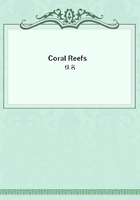
第11章
The lagoon alone remains to be described; it is much shallower than that of most atolls of considerable size. The southern part is almost filled up with banks of mud and fields of coral, both dead and alive, but there are considerable spaces, between three and four fathoms, and smaller basins, from eight to ten fathoms deep. Probably about half its area consists of sediment, and half of coral-reefs. The corals composing these reefs have a very different aspect from those on the outside; they are very numerous in kind, and most of them are thinly branched. Meandrina, however, lives in the lagoon, and great rounded masses of this coral are numerous, lying quite or almost loose on the bottom. The other commonest kinds consist of three closely allied species of true Madrepora in thin branches; of Seriatapora subulata; two species of Porites (This Porites has somewhat the habit of P. clavaria, but the branches are not knobbed at their ends. When alive it is of a yellow colour, but after having been washed in fresh water and placed to dry, a jet-black slimy substance exuded from the entire surface, so that the specimen now appears as if it had been dipped in ink.) with cylindrical branches, one of which forms circular clumps, with the exterior branches only alive; and lastly, a coral something like an Explanaria, but with stars on both surfaces, growing in thin, brittle, stony, foliaceous expansions, especially in the deeper basins of the lagoon. The reefs on which these corals grow are very irregular in form, are full of cavities, and have not a solid flat surface of dead rock, like that surrounding the lagoon; nor can they be nearly so hard, for the inhabitants made with crowbars a channel of considerable length through these reefs, in which a schooner, built on the S.E. islet, was floated out.
It is a very interesting circumstance, pointed out to us by Mr. Liesk, that this channel, although made less than ten years before our visit, was then, as we saw, almost choked up with living coral, so that fresh excavations would be absolutely necessary to allow another vessel to pass through it.
The sediment from the deepest parts in the lagoon, when wet, appeared chalky, but when dry, like very fine sand. Large soft banks of similar, but even finer grained mud, occur on the S.E. shore of the lagoon, affording a thick growth of a Fucus, on which turtle feed: this mud, although discoloured by vegetable matter, appears from its entire solution in acids to be purely calcareous. I have seen in the Museum of the Geological Society, a similar but more remarkable substance, brought by Lieutenant Nelson from the reefs of Bermuda, which, when shown to several experienced geologists, was mistaken by them for true chalk. On the outside of the reef much sediment must be formed by the action of the surf on the rolled fragments of coral; but in the calm waters of the lagoon, this can take place only in a small degree. There are, however, other and unexpected agents at work here: large shoals of two species of Scarus, one inhabiting the surf outside the reef and the other the lagoon, subsist entirely, as I was assured by Mr. Liesk, the intelligent resident before referred to, by browsing on the living polypifers. I opened several of these fish, which are very numerous and of considerable size, and I found their intestines distended by small pieces of coral, and finely ground calcareous matter. This must daily pass from them as the finest sediment; much also must be produced by the infinitely numerous vermiform and molluscous animals, which make cavities in almost every block of coral.
Dr. J. Allan, of Forres, who has enjoyed the best means of observation, informs me in a letter that the Holothuriae (a family of Radiata) subsist on living coral; and the singular structure of bone within the anterior extremity of their bodies, certainly appears well adapted for this purpose.
The number of the species of Holothuria, and of the individuals which swarm on every part of these coral-reefs, is extraordinarily great; and many shiploads are annually freighted, as is well-known, for China with the trepang, which is a species of this genus. The amount of coral yearly consumed, and ground down into the finest mud, by these several creatures, and probably by many other kinds, must be immense. These facts are, however, of more importance in another point of view, as showing us that there are living checks to the growth of coral-reefs, and that the almost universal law of "consumed and be consumed," holds good even with the polypifers forming those massive bulwarks, which are able to withstand the force of the open ocean.